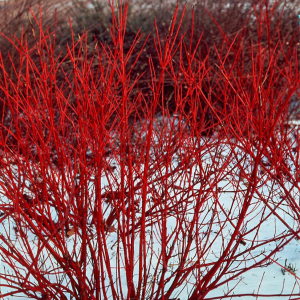The month of April has been designated as Native Plant Month in Ohio! This month, please consider planting a native tree in your yard or community, plant one small plant or an entire garden to support native bees, butterflies, and other pollinators, participate in a wildflower walk to enjoy our wonderful spring ephemerals, replace a small lawn area with beneficial native plants, or remove invasive plants from your yard to provide a natural habitat for native plants to thrive.
City Forester Marylou Bohannon has put together a list of five plants that are easy to grow, beautiful, and provide benefits to wildlife and the environment. They are also common in our local nurseries and available in a variety of cultivars to meet the needs of various landscapes.
Red osier dogwood (Cornus sericea)

(Picture courtesy: Home Depot)
This shrub, often called red twig dogwood, provides great winter interest in the garden thanks to its brightly colored branches. White flowers appear in late spring and are followed by interesting white berries. The red branches are accompanied by red leaves in the fall. This shrub can be 8 feet tall and 10 feet wide making it ideal for screening, and it tolerates a wide range of sun and soil conditions.
Cardinal Flower (Lobelia cardinalis)

(Picture courtesy: Oakland Nursery)
Cardinal flower is a perennial plant that produces 3 foot tall red flower spikes mid-summer though early fall attracting hummingbirds and butterflies all the while. It does best with some afternoon shade and can tolerate standing water making it a great plant for areas that don’t drain well. Some parts of the plant are toxic, so be considerate of kids and pets when planting.
Ninebark (Physocarpus opulifolius)

(Picture courtesy: Home Depot)
Ninebark is another great native shrub for hedges and screening, but comes in compact forms and a wide variety of leaf colors from green to burgundy at local nurseries. The white flowers bloom in early summer. Ninebark thrives in full sun to partial shade and a wide variety of soil conditions.
Serviceberry (Amelanchier laevis)

(Picture courtesy: North Carolina State)
Serviceberries are small trees that often grow to 25 feet tall. They are also grown with multiple stems as a large shrub. It flowers in the spring and is a good replacement for the invasive pear tree that flowers at the same time. The fall color is red, and this tree comes in many cultivars and varieties. It prefers part-shade light and tolerates a wide range of soil types, but not drought.
Purple Coneflower (Echinacea purpurea)

The purple coneflower is a great perennial for attracting butterflies and birds to your yard. It prefers full sun, and once established this plant is drought tolerant. The purple flowers bloom throughout the summer.
- For a complete native plant list, click here.
- For a native tree list, click here.
- For more information about Ohio Native Plant Month, click here.


Follow Us & Use #newalbanyohio
4 days ago
Photo
Share on Facebook Share on Twitter Share on Linked In Share by Email
4 days ago
Photo
Share on Facebook Share on Twitter Share on Linked In Share by Email
5 days ago
Photo
Share on Facebook Share on Twitter Share on Linked In Share by Email
5 days ago
Video
Share on Facebook Share on Twitter Share on Linked In Share by Email
6 days ago
Photo
Share on Facebook Share on Twitter Share on Linked In Share by Email